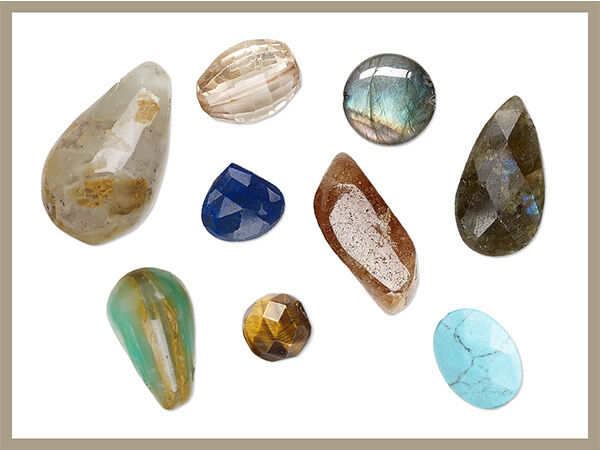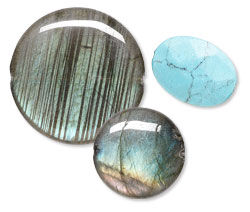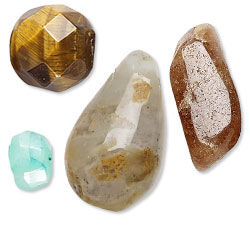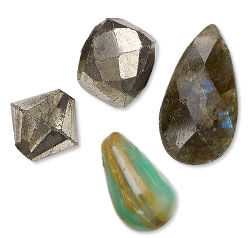Gemstone Grading
There are a lot of steps to grade a gemstone. Each step of grading focuses on a different feature and has many details that create the overall grade determination. It can be difficult to understand gemstone grades without training, so with the help of the Fire Mountain Gems and Beads gemologists we've created a chart to help clarify the basics. Images of both emerald and lapis lazuli are shown to illustrate transparent and opaque versions of each grade. There are other factors taken into consideration when grading colored gemstones such as the quality and rarity of the material, enhancements, overall size of the stone, uniformity of shape, quality of cutting/faceting and the combination of graded features.
| Grade | Hue and Color Saturation | Color Tone | Inclusions | Transparency/Opacity | Cutting, Surface, Drilling |
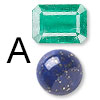 |
Color is the hue expected. Color saturation is vivid and even througout the stone. | Color tone is rich, but not so dark as to be near the far end of the spectrum. | There are few, if any, inclusions. Any inclusions will be small and hard to spot with the naked eye. | Translucency/Opacity is as expected for the specific stone. | Cutting or shape is uniform. Surface has a smooth luster, high polish and no cracks or chips. The drilling of the hole is even and uniform. |
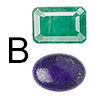 |
Color is the hue expected, but may not be as vivid as an A grade. Saturation is fairly even throughout the stone. | Color tone is good, but may be lighter or darker than an A grade stone. | A few inclusions are seen, but they are small and unobtrusive. | The stone may not have the clarity or opacity of the same stone in an A grade. | Cutting or shape may exhibit some slight variances. Surface has a medium luster and moderate polish, cracks or chips are minimal and drilling is generally uniform. |
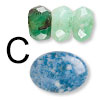 |
The color of the stone is within the hue expected, but may not be vivid or even. | Color tone is significantly lighter or darker--near the ends of the spectrum. | Inclusions or matrix mineral content is more apparent and frequent. These will be easily visible to the naked eye. | The stone may vary greatly in clarity/opacity from that expected. | Cutting or shape exhibits some variances. Surface has a medium to low luster and polish. Cracks or chips are more apparent. Drilling may lack uniformity. |
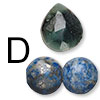 |
Color of the stone is generally the color expected, but saturation is low and very uneven. | Color tone can be so deep it seems black or so light it seems colorless. | Inclusions are frequent and greatly affect the overall look of the stone. | Stones expected to be transparent may be opaque or be heavily included. Stones expected to be opaque may have less original material and more "other" mineral content, causing more transparency. | Cutting or shape can be irregular. Surface has poor luster with cracks or chips. Drilling can be uneven. |
Gemstone Bead Grading
The grading of gemstone beads follows its own set of standards, distinct from those applied to high-end faceted gems—but related to them. Continue reading to discover Fire Mountain Gems and Beads' gemstone bead grading system and the general attributes we consider when determining the grade of a bead.
Identification:
Identification of the stone is always the first aspect of gemstone bead grading. Many gemstones, including amber, have specific characteristics that make them what they are. Although there are A grades of gemstone beads, the largest and best-quality gemstones are usually cut into faceted gems for the high-end jewelry industry. The rougher stones will be made into beads. Bead cutters will use the better materials to cut the A grades for the bead industry, and according to the stone variety, separate the remaining stone into the B and C grades, and so on.
Color:
Fire Mountain Gems and Beads experts look for specific levels of color saturation for each type of gemstone. Bead colors are meticulously assessed, adhering to the highest standards specific to each gemstone. For example, the color of amethyst varies according to the country of origin. The color saturation can be dark, medium or light. The optimum color for Fire Mountain Gems and Beads’ amethyst is a deep vibrant purple, but it must not be overly dark. Untreated stones receive a higher grade because of their natural state.
Clarity:
Clarity refers to the lack of inclusions in a stone. Some types and varieties of gemstones will always have inclusions, whereas others, such as aquamarine, can be inclusion free. Each gemstone variety is graded based on the specific standards applicable to its type. Best-grade smoky quartz (Quartz Specie), for example, can be inclusion free, whereas best-grade amethyst and citrine will nearly always have minor inclusions. Better grade stones will have brilliant, evenly distributed color. They will have fewer inclusions and will be ideal for cutting. Opaque stones, where clarity is not a factor, will be graded higher for traits like rich saturation of color or good contrast of color depending on the type of stone. For example, a better grade bloodstone (Chalcedony Specie) will be semitranslucent to a dark opaque green with spots of russet to ripe-tomato red. Fire Mountain Gems and Beads offers many books as well as our EncycloBEADia® to reference stone types with their physical and purported metaphysical properties.
Cut:
Cut refers to the finish on a bead—smooth or faceted. Faceting adds sparkle to translucent and opaque gems and is generally performed on better grades and harder materials.
Fire Mountain Gems and Beads carries two types of faceted gems—machine- and hand-faceted. On the best grades of machine-faceted beads, the cutting will be precise, uniform, well-polished and well-drilled. The smaller the facets, the more reflective brilliance a bead will have. Hand-faceted, hand-polished (handwrought) beads will be less uniform in their overall shape and in the shape and size of the facets. This adds a twinkling allure to a handwrought finished product. Because most handwrought beads are originally sold by carat weight, the drill holes are small to keep as much finished weight as possible .
The best grades of smooth beads should have a high-luster polish and a smooth surface free of pitting, voids or surface imperfections (unless they’re a characteristic of the natural material). Fire Mountain Gems and Beads offers expert stringing materials for all types of faceted and smooth beads.
Our buyers are experts in the field with years of accumulated training. They maintain ongoing training in industry standards and understand the fluctuating availability of gemstone materials. Because—as opposed to faceted gemstones—there are few regulatory standards for gemstone beads, Fire Mountain Gems and Beads has developed its own, and employs on-site Graduate Gemologists® certified by the Gemological Institute of America (GIA) to ensure accurate standards of grading and authentication of our gemstone materials. Fire Mountain Gems and Beads is a charter member of American Gem Trade Association (AGTA) and adheres to their standards for enhancement codes for all gemstones.
With the presentation of our gemstone bead standards, Fire Mountain Gems and Beads seeks to foster an understanding of the intricacies of gemstone bead grading as well as an assurance of Fire Mountain Gems and Beads' diligence in identification, grading and enhancements on your behalf.
How did you like this resource? Email Customer Service.
Copyright Permissions
All works of authorship (articles, videos, tutorials and other creative works) are from the Fire Mountain Gems and Beads® Collection, and permission to copy is granted for non-commercial educational purposes only. All other reproduction requires written permission. For more information, please email copyrightpermission@firemtn.com.
